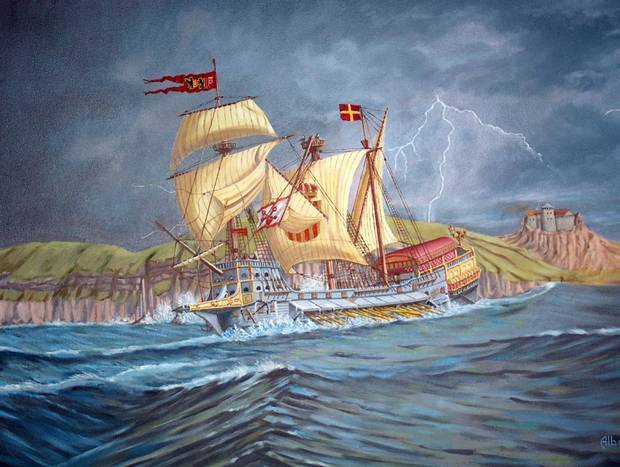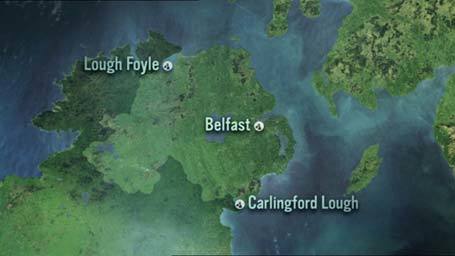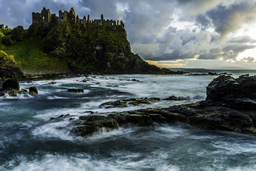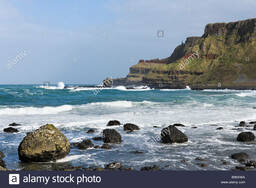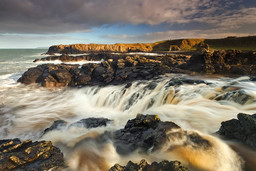The fact is that the early Irish were a seafaring race is revealed in ancient manuscripts, and confirmed by modern archeology. From as early as 7000 BC, Ireland’s settlers came across the seas; from the Fir Bolg, who escape from Greece in boats made of wood and leather, to the Celts of Iberia, who came in a fleet of ships with which they traded along the coast of Europe. This is confirmed by ancient stone structures built as celestial calendars, in astronomical alignment with solar and lunar activity. The rising sun on the winter solstice still performs its magic at Newgrange just as it did 5,000 years ago.
Irish Sail the World
Their seafaring ability brought Celtic sailors to America long before the time of Christ /
St. Brendan wrote of sailing to America, and the history of Iceland records the visits of Irish monks to their shores long before the Vikings,
The only remaining part repository of the navigational skill of their Celtic forefathers is the fishermen; but their time too, was at hand.
Irish Seafarers Grounded
As the Irish were driven from their lands across the east and south, coastal tracts became the property of English landlords. Without access to the sea, many Irish fishing families were forced to turn to the land for sustenance. The rocky north coast did little to encourage a great dependency on fishing, but the natural harbors, bays, and inlets of the west coast were ideal, and a good number of Irish continued to make their living from the sea. As the 1800s dawned, absentee Landlords began to drain the economy of Ireland by exporting her natural produce, and spending the profits in England, leaving nothing to support Crown institutions in Ireland. The result was high taxes and the most exorbitant rents in Europe. In addition, the Crown levied a ten percent tithe on the Irish to support the Church of England – an institution to which they didn’t even belong. In many cases, after rents were paid to secure a place to live, there was not enough left for tithes and taxes. In order to satisfy outstanding debts, property was confiscated; in many cases in the west those properties were nets and fishing boats. Others, unable to afford to buy enough salt to preserve their catch for the winter, sold their boats and gear and joined their fellow Irishmen who had already turned to the land for a living.
As more and more were added to the already rapidly expanding population trying to earn a living from the limited small plots of land, the Irish turned to the one crop that could produce the most yield per acre – the potato. The stage was now set for the most tragic event in Irish history. When the potato failed in 1845 through 1850, the Irish starved. They starved as they watched the landlord’s crops transported under guard to waiting ships for export; they starved as they watched the salmon leaping in the landlord’s streams; and they starved as they watched the trout snapping the May-fly from the surface of the landlord’s lakes; they starved because these things were forbidden them. But hardest of all was the sight of the silver shoals of herring off the Irish coast, for although the sea was not the landlord’s property, the Irishman’s nets and boats lay rotting in the landlord’s shed. Thus was a seafaring people grounded; thus was a living tradition that encompassed the most advanced seafaring skills of its time, ruthlessly reduced.
A Tradition Revived
But where there is a spark there is a flame, and the fishermen of the outer islands off the west coast of Ireland kept that spark alive. After the expulsion of the Crown, the shark hunters of Aran, with their unique curraghs, and Connemara fishermen with their Galway Hookers inspired a resurgence in seafaring. In modern Ireland, there are many clubs and organizations building these traditional old craft for the purpose of fishing, racing and pleasure. The Galway Hooker Association, founded in 1978 for the purpose of promoting the restoration and preservation of traditional boats, stages at least a dozen annual races and festivals called Cruinniu na mBad (the gathering of the boats) along Ireland’s west coast from mid-May to Mid-September which attracts thousands. But more important, since the realization of the Irish Republic, Irish fishermen have returned to the sea to hunt the shoals of herring as their ancestors did for centuries, confident that this time they can pass the tradition to their sons without fear that it will be stolen or suppressed
